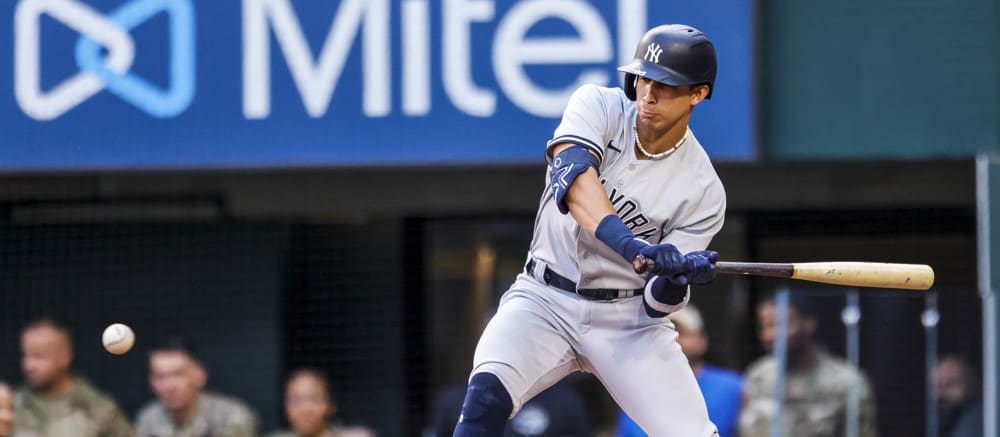Last time, we looked at infield sleepers to consider late in drafts, and now we're moving into the outfield. In five-outfielder leagues, it can be challenging to identify enough quality options late in the draft. Often, as is the case with some members of this list, you might find yourself turning to glove-first players whose defense keeps them in the lineup on a regular basis, as long as they have enough offensive tools to be fantasy-relevant. The ADP market is generally quite efficient, so the outfielders available late in drafts won't be without their flaws. There's a low likelihood that these players hit, but all come with enough potential payoff to be worth targeting late in drafts.
Oswaldo Cabrera (OF, NYY)
The Harrison Bader oblique injury frees up playing time in the outfield, presumably shifting Aaron Judge or Aaron Hicks into center field and allowing Cabrera's stock to rise. With most of the buzz in Yankees camp centering on Anthony Volpe and Oswald Peraza, Cabrera deserves more attention. He holds real-life value as a utility player, serving mostly as an outfielder last season while spending a few games at each infield spot. The defensive metrics point toward Cabrera as a solid outfield defender with a strong arm.
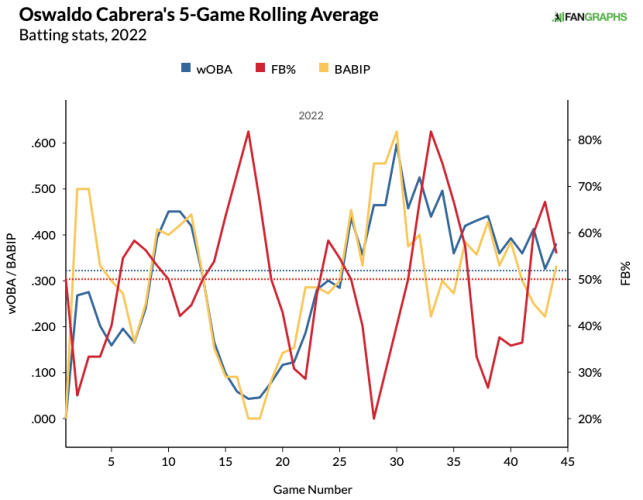
A switch-hitter, Cabrera leans into the flyball approach, posting a 50 percent flyball rate while spraying the ball all over the field. That heavy flyball approach could negatively impact his batting average upside as seen in the small sample of the rolling graph above. He chased a few points more than the league norms but showed league-average contact rates.
Though it's a small sample of 112 batted ball events, Cabrera had a 6.3 percent barrel rate and 91.3 mph average exit velocity on flyballs and line drives, ranking 285th among the 411 hitters with at least 100 batted ball events last year. Those power skills look mediocre, but he boasted above-average power grades as a prospect. He may not have an exciting level of pop, but should still manage 12-15 home runs or more in a hitter-friendly environment.
The speed component is the wild card. Cabrera flashed average speed skills, covering 90 feet in 4.01 seconds, which tied for 226th. Other players with a similar 90-foot split include Christian Arroyo, Dylan Carlson and Ian Happ. Unfortunately, Cabrera's stolen base opportunities might remain a question mark since the Yankees hovered near the league average in stolen base rate at 76 percent. Considering Cabrera converted a modest 72 percent of his opportunities at Triple-A and the majors last year, so he'll probably need to compile plenty of plate appearances to reach double-digits.
Since Bader's injury news (March 10), Cabrera's NFBC Online Championship ADP barely moved (from 329 to 324), with a minimum pick of 247. Bader's injury is expected to keep him out for about six weeks from the date it occurred, so that secures Cabrera's playing time for the first month or so of the season. At this point in the draft, most of the available players have concerns related to their skills, playing time or health, but Cabrera has some early at-bats locked up and the skills to compile 12-15 home runs and 8-10 stolen bases over a full season. Target Cabrera as OF4 or OF5 in 15-team mixed leagues.
Enrique Hernandez (OF, BOS)
In my recent 15-team leagues, Hernandez keeps landing into my lap in the later rounds. Maybe it's a personal bias or maybe it's an opportunity to grab some undervalued playing time. Like Cabrera, Hernandez doesn't pop off the page from a skills standpoint, so one might think he lacks upside. While we might dream of a repeat of 2021, he only produced $10 of earned value that year since he stole just one base. Hernandez is outfield eligible but should earn middle infield eligibility soon, as he's expected to open the year at shortstop.
Outside of Rafael Devers, Alex Verdugo and a few others, the Red Sox lineup looks different than it did in past seasons. There's a chance Hernandez moves into the leadoff spot; Triston Casas and Masataka Yoshida are also candidates, but the latter will reportedly be batting cleanup. From a skills standpoint, Hernandez uses a pull-heavy flyball approach and has run into unfortunate luck in the home run department. Expect his home run luck factors to regress in his favor, especially when we consider he dealt with a hip flexor injury that kept him out over two months last year.
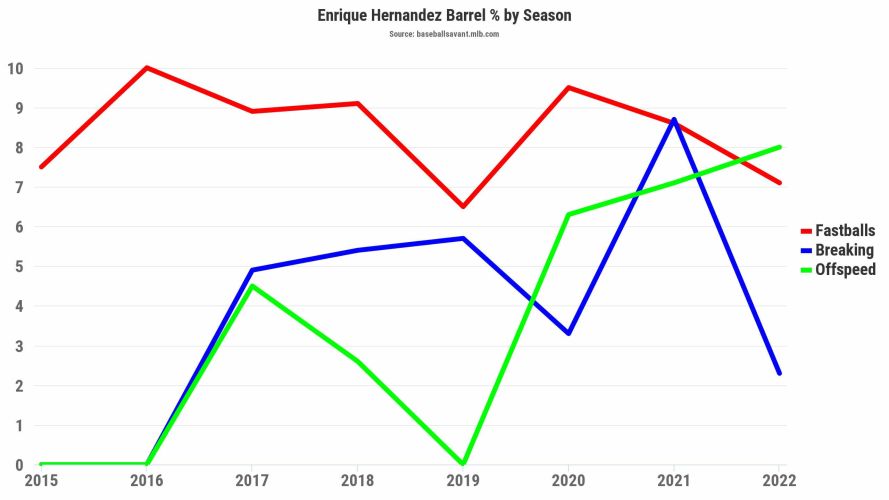
We're speculating, but it's logical to consider a hip injury impacting the way he strikes the ball. That aligns with his decline in barrel rate, which fell from 8.4 percent in 2021 to 5.8 percent in 2022. Hernandez's exit velocity on flyballs and line drives also dropped slightly from 93.7 mph (2021) to 92.6 mph (2022), though his maximum exit velocity improved to a career-high. From a plate discipline standpoint, Hernandez's 2022 numbers align with the career norms, and hopefully, his batted ball quality rebounds.
Given Hernandez's flyball approach, it's hard to expect a leap in batting average. It's reasonable to expect it to regress closer to his career norms (around .240), with 15+ home runs incoming if he stays healthy. The lack of stolen bases weighs down his fantasy value, but Hernandez should provide solid value in three categories as a late-round outfield target around pick 330 to 350.
Alek Thomas (OF, ARI)
The Corbin Carroll hype train is through the roof, and rightfully so. However, Thomas warranted plenty of prospect hype in recent memory. From a real-life perspective, Thomas is an athletic defender in center field with a 92nd percentile Outs Above Average. Thomas initially flashed the power and speed we drool over, then struggled and sat against lefties before being sent down to Triple-A. In the first half, Thomas hit .250 with a .707 OPS and a 97 wRC+, which fell to a .207 BA, .508 OPS, and 40 wRC+ after the break.
We shouldn't overreact to the 91 plate appearance sample, but there's some trepidation regarding his splits versus lefties, as he finished with a .471 OPS and 30 wRC+. Unfortunately, he wasn't drastically better against righties, posting a .665 OPS and 84 wRC+. I prefer to look at his skills and inputs rather than focus on his outputs and results, and it seems there's more untapped potential. Thomas's chased 36.6 percent of the time, four points higher than the league average, but posted league-average contact rates.
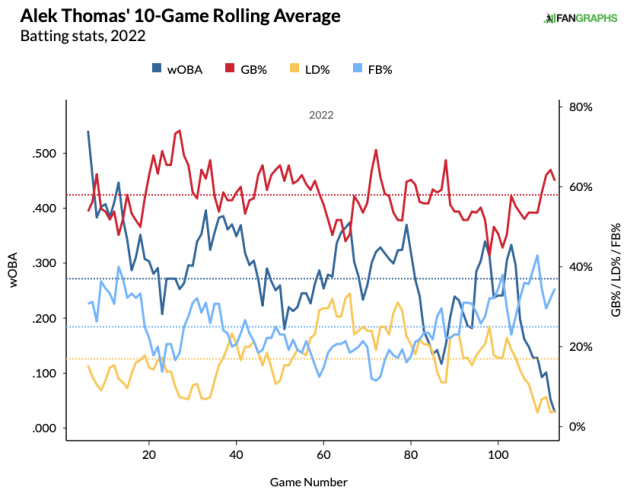
Thomas pounded the ball into the ground 58 percent of the time, which impacted his launch angle and led to a 3.8 percent barrel rate. The graph above demonstrates the inverse relationship between Thomas' higher groundball rates and his lower wOBA. He had high groundball rates throughout the minors, indicating this might be more the norm than an outlier season. We'll need to see more consistency, though he flashed a solid maximum exit velocity of 111.3 mph (75th percentile) and hit 29.2 percent of his batted balls over 100 mph. Ideally, Thomas's sprint speed (95th percentile) translates into a more successful stolen base conversion rate going forward than his 61 percent over the past two seasons in the minors and MLB.
Yes, Thomas has strong-side platoon concerns, though don't overreact to the rookie sample. Thomas's defensive ability should give him a slightly longer leash if he struggles offensively. Around pick 330 to 350, Thomas is worth the gamble as an OF5 or bench bat with his double-digit home run and stolen base potential. Over an entire season's worth of plate appearances, Thomas can compile 15 home runs and 10 stolen bases with a reasonable .250-.260 batting average. We might be a year early on Thomas, similar to Josh Lowe last year, but the potential skills are tempting with this outfield sleeper.
Kyle Isbel (OF, KC)
After some sleeper appeal prior to last season, Isbel flashed power and speed alongside an unappealing batting average (.211). Isbel's defensive skills should keep him in the lineup, as his Outs Above Average finished in the 97th percentile. Hopefully, Isbel hits enough, because there's already platoon risk given his .577 OPS versus lefties and .657 OPS against righties for his career. That adds more risk to a player who's been a below-average hitter thus far, though Isbel does have some skills that warrant intrigue.
Isbel makes a healthy amount of contact, posting a contact rate four points higher than the league norm. While he could benefit from elevating the ball more, he pulls the ball 47.8 percent of the time. It could be an attempt to tap into some pull-side power, making his 4.9 percent barrel rate potentially misleading. Isbel boasted an above-average maximum exit velocity, plus a sneaky 94.9 mph exit velocity on flyballs and line drives, good for 65th among hitters with at least 150 batted ball events. That indicates Isbel crushes the ball when he elevates it.
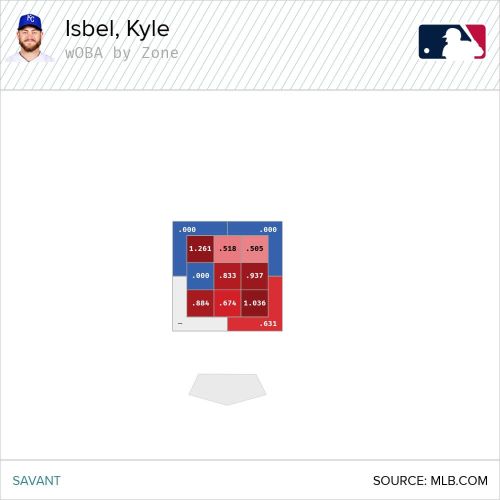
The visual above shows Isbel's wOBA by zone on pulled flyballs and line drives, as he tends to prefer turning on the pitches low and inside. Per Baseball Savant, Isbel averages a 98.7 mph EV on pulled flyballs and line drives, which hovered near Vinnie Pasquantino, Jake Burger, Keston Hiura, Riley Greene and Pete Alonso. While I don't expect Isbel to perform as a power hitter with 20+ home runs, it at least hints at potential power development.
Meanwhile, on the speed front, Isbel's conversion rate of 60 percent on stolen base attempts wasn't great. However, his 29 percent stolen base opportunity rate shows he may have the volume to post peak stolen base totals of 15-20 or more. The Royals hovered near the average stolen base success rate, and they tied for the sixth-most as a team last season. Isbel probably hits toward the bottom half of the Royals lineup, which impacts his runs and RBI, though his home runs and stolen bases will buoy his fantasy value. Take a chance on Isbel in one of the final rounds of a 15-team mixed league since he's one of many Royals with the potential for double-digit home runs and stolen bases.
Jesus Sanchez (OF, MIA)
The Marlins have several toolsy players with a wide range of possible outcomes. If those tools translate and improve, those players could reach their peak outcomes like Jazz Chisholm seems to be doing. The hit tool lagged for Chisholm, but his power and speed popped off the chart. Chisholm elevated his stock via his admirable on-field production and personality, and Sanchez could follow suit. With Sanchez, the plate discipline isn't as concerning as one would expect. His contact rates gradually improved from 2021, especially in the zone. As seen in the following graph, Sanchez chases pitches, but not much more frequently than the league norm.
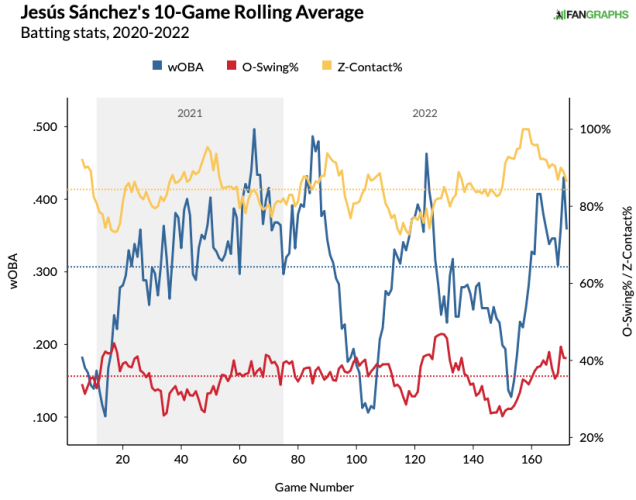
Often we'll find that hitters with hit tool concerns like Sanchez struggle to make contact. Fortunately, that's not the case for Sanchez, or at least not to an overly concerning level. Though he sports a heavier groundball rate at 46.6 percent, he elevates the ball enough to boast near-elite exit velocities. Over the past two seasons, Sanchez has an 11 percent barrel rate, tying him with Jarred Kelenic, Danny Jansen and Darin Ruf. If he adjusts his launch angle, expect his barrel rate to improve by a few points, pushing him into elite territory.
Sanchez's maximum exit velocities ranked in the top 10 percent of the league in the last two years. Last season, he averaged an exit velocity of 95.3 mph on flyballs and line drives, good for 41st out of the 281 hitters with at least 200 batted ball events, which further demonstrates his power. The visual below shows Sanchez's wOBA by zone on pulled flyballs and liners, as his preferred way to attack the ball is with pull-side power.
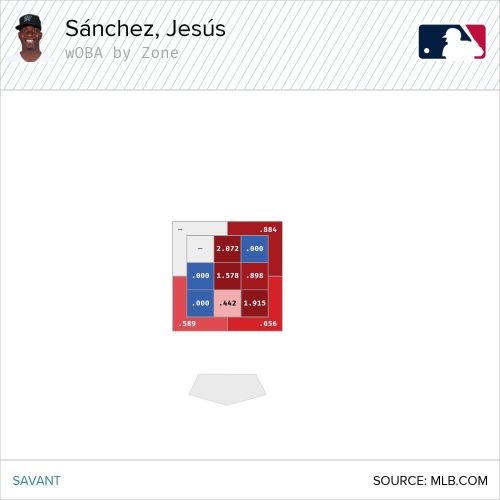
One main concern involves platoon risks, evidenced by the .558 OPS against lefties and .760 OPS versus righties. While that number comes from only 138 career plate appearances versus lefties, Sanchez may end up in a strong-side platoon role to begin the season. Based on Sanchez having zero minor-league options, there's a good chance he makes the Opening Day roster unless the Marlins ship him in a trade to open up playing time for Bryan De La Cruz, who posted respectable numbers in 2022.
The wild card that could boost Sanchez's value is stolen bases. In spring training, Sanchez already has three steals and has yet to be caught stealing. That's a notable development, because Sanchez has attempted just two stolen bases in his 565 MLB plate appearances to date. He ran a tad more in the minors, with six attempts in 79 games at Triple-A in 2021 and 2022, and nine attempts in 78 Double-A games in 2019. Sanchez has flashed average to above-average speed in the majors, and the Marlins ranked 10th (2021) and fourth (2022) in stolen base rate under Don Mattingly. Skip Schumaker is replacing Mattingly, so there's a chance that the trend shifts, but Sanchez is still worth a last-round pick with the skills and tools we're looking for in an outfield sleeper.
